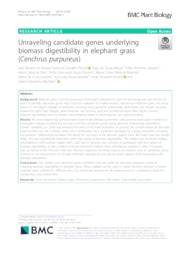Unraveling candidate genes underlying biomass digestibility in elephant grass (Cenchrus purpureus).
Unraveling candidate genes underlying biomass digestibility in elephant grass (Cenchrus purpureus).
Author(s): ROCHA, J. R. do A. S. de C.; MARÇAL, T. de S.; SALVADOR, F. V.; SILVA, A. C. da; CARNEIRO, P. C. S.; RESENDE, M. D. V. de; CARNEIRO, J. da C.; AZEVEDO, A. L. S.; PEREIRA, J. F.; MACHADO, J. C.
Summary: Background: Elephant grass [Cenchrus purpureus (Schumach.) Morrone] is used for bioenergy and animal feed. In order to identify candidate genes that could be exploited for marker-assisted selection in elephant grass, this study aimed to investigate changes in predictive accuracy using genomic relationship information and simple sequence repeats for eight traits (height, green biomass, dry biomass, acid and neutral detergent fiber, lignin content, biomass digestibility, and dry matter concentration) linked to bioenergetics and animal feeding. Results: We used single-step, genome-based best linear unbiased prediction and genome association methods to investigate changes in predictive accuracy and find candidate genes using genomic relationship information. Genetic variability (p < 0.05) was detected for most of the traits evaluated. In general, the overall means for the traits varied widely over the cuttings, which was corroborated by a significant genotype by cutting interaction. Knowing the genomic relationships increased the predictive accuracy of the biomass quality traits. We found that one marker (M28_161) was significantly associated with high values of biomass digestibility. The marker had moderate linkage disequilibrium with another marker (M35_202) that, in general, was detected in genotypes with low values of biomass digestibility. In silico analysis revealed that both markers have orthologous regions in other C4 grasses such as Setaria viridis, Panicum hallii, and Panicum virgatum, and these regions are located close to candidate genes involved in the biosynthesis of cell wall molecules (xyloglucan and lignin), which support their association with biomass digestibility. Conclusions: The markers and candidate genes identified here are useful for breeding programs aimed at changing biomass digestibility in elephant grass. These markers can be used in marker-assisted selection to grow elephant grass cultivars for different uses, e.g., bioenergy production, bio-based products, co-products, bioactive compounds, and animal feed.
Publication year: 2019
Types of publication: Journal article
Unit: Embrapa Forestry
Observation
Some of Embrapa's publications are published as ePub files. To read them, use or download one of the following free software options to your computer or mobile device. Android: Google Play Books; IOS: iBooks; Windows and Linux: Calibre.
Access other publications
Access the Agricultural Research Database (BDPA) to consult Embrapa's full library collection and records.
Visit Embrapa Bookstore to purchase books and other publications sold by Embrapa.

